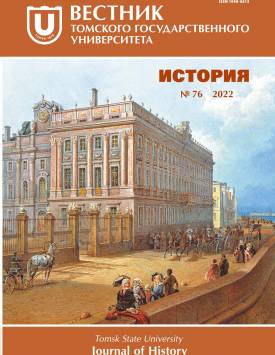The reaction of the military personnel of the Special Red Banner Far Eastern Army (SRBFEA) and their relatives to collectivization and dekulakization in the USSR in the early 1930s
Active and thorough study of the collectivization of the agriculture and the dekulakization in the USSR started only two decades ago. But social and psychological factor, which is connected with the reaction of the country’s population to the government policy in agriculture in early 1930s, has not been described in historical literature yet. Many SRBFEA officers and soldiers descended from peasant families, and their reaction was ambiguous and depended on different political and ideological and social and economic aspects of country life. The purpose of the article is to examine and analyze quotations as one of the most important forms of reactions of the military staff and their relatives to the Soviet government’s policy in collectivization of agriculture and dekulakization in the USSR in early 1930s. The quotations can be found in archives most of which are introduced into the science for the first time. To this end it is especially important to reveal the reasons why these or those reactions emerged and developed, to analyze their character and constituents, as they influenced the all-Union judgements of the population regarding the state policy. Soldiers of the Red Army who served in the Far East of the USSR came from villages and were of different social and economic levels of peasantry. Some of them were positive about the government actions because they were motivated by the expectations of the future socially fair society with equal rights for every citizen, and by the hope on significant material aid of the state in development of collective farms. Approval shown by some of the peasants was determined by the fact that in spite of the hard conditions of agricultural production in most of the regions collective labour was more productive, especially in the conditions of decreased male population after the First World War and the Civil War. The part of the peasantry who for some reasons could not or would not improve their social and economic situation hoped to limit the influence of the rural bourgeoisie in the country. Critical and negative reaction came from the SRBFEA soldiers and their relatives who had economically strong and prosperous peasant farms and were able to adapt to the new conditions of life during the Soviet years. As a rule, they relied only on themselves in increasing of labour productivity. Since late 1920s the collectivization policy damaged individual farms and caused natural negative reaction of the kulaks and the economically strong middle peasants. Understanding the threat of such reaction the government of the country treated these people as politically unreliable and made them change their places of residence while their property was passed on to the collective farms. This information was transferred to the SRBFEA divisions by mail and orally where it became the subject of many discussions and the reason of different reactions. Contribution of the authors: the authors contributed equally to this article. The authors declare no conflicts of interests.
Keywords
Far East of the USSR, SRBFEA, military personnel, peasant moods, summaries, the political department, collectivization, dekulakization, peasants, the poor, middle peasants, the kulaks, collective farmAuthors
| Name | Organization | |
| Isaev Aleksandr A. | Far Eastern Federal University | isaev.aa@dvfu.ru |
| Fedirko Oksana I. | Institute of history, archeology and ethnography of the peoples of the Far-east Far-eastern branch of Russian Academy of Sciences | fedirko@ihaefe.ru |
References

The reaction of the military personnel of the Special Red Banner Far Eastern Army (SRBFEA) and their relatives to collectivization and dekulakization in the USSR in the early 1930s | Tomsk State University Journal of History. 2022. № 76. DOI: 10.17223/19988613/76/2
